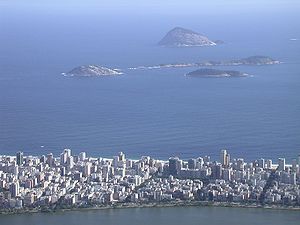Ilhas Cagarras
23°01′49″S 43°12′01″W / 23.03028°S 43.20028°W

The Cagarras Islands (in Portuguese Ilhas Cagarras) make up an uninhabited archipelago located 5 km or 3 miles off Ipanema, a major beach of the southern coast of the city of Rio de Janeiro, Brazil, outside Guanabara Bay (23801’00’’W 43812’00’’S), and occupy an area of 2 km2. It is an important area for fisheries and tourism, and is subjected to upwelling of cold waters during summer.[1] The water quality is relatively poor due to its close proximity with Rio's city waste water disposal. The archipelago consists of the following islands ("ilha" in Portuguese means island, "ilhota" = islet):
- Ilha Cagarra
- Ilha de Palmas
- Ilha Comprida
- Ilha Filhote
- Ilhota Grande
- Laje de Cagarra
The first three are the largest. Ilha Cagarra, the island group's namesake, is the tallest (79m/259 ft.) and most visible from land. Although the islands Ilha Redonda and Ilha Redondinha are located nearby, they are not part of the Cagarras archipelago.
Origin of the name
There is no consensus among authors about the origin of the name of this archipelago. The most commonly accepted version says that the toponymy would be due to the large amount of excrement ( in Portuguese, "cagarra" ) of seabirds that live, nest and feed on these islands. After feeding mainly on fish, these birds excrete their feces, rich in calcium, on the rocky slopes of the islands, staining them white. This hue is clearly visible from the shore of Ipanema, one of the south beaches of Rio de Janeiro In 1730, Cory's Shearwater, its main island, appears on a nautical chart with a Frenchified name "Island Cagade." In another letter, dated 1767, the same appears with the island carrying its name in Portuguese: "Crappy Island." Another fact, at least curious, is that the name of the archipelago is also that of a bird that lives in the archipelagos of Madeira and the Azores (Portuguese territories): the shearwater or cagarro ("Calonectris diomedea") but is not found on Brazilian islands.
History of the Archipelago
On 13 April 2010 the incumbent vice president José Alencar signed a decree creating the "National Monument Cagarras" on the initiative of Mr Fernando Gabeira of the Green Party; the islands are therefore a unit of environmental preservation. They are situated in proximity to the discharge in the sea of sewage from almost all the South Zone of Rio de Janeiro, through the canal of Ipanema, an important work of sanitary engineering built in the 1970s in accordance with the Protocol of Annapolis. The islands are nonetheless frequented by day excursions of eco-tourists.
References
- ^ J. Mar. Biol. Ass. U.K. (2004), 84, 681^687

